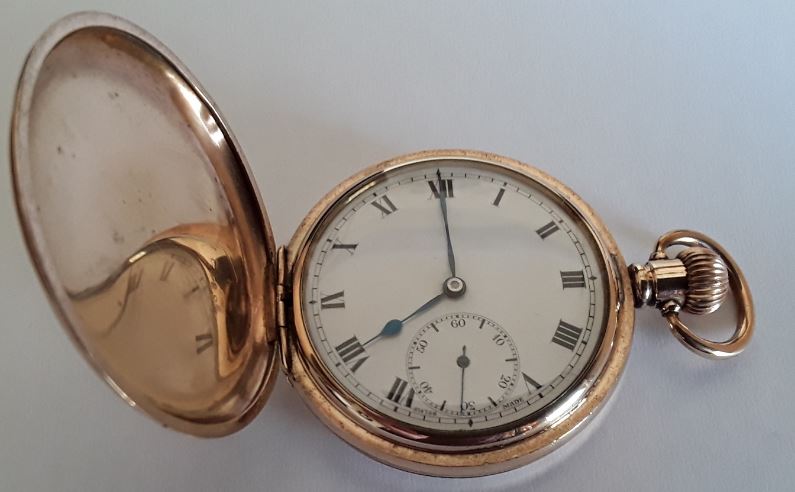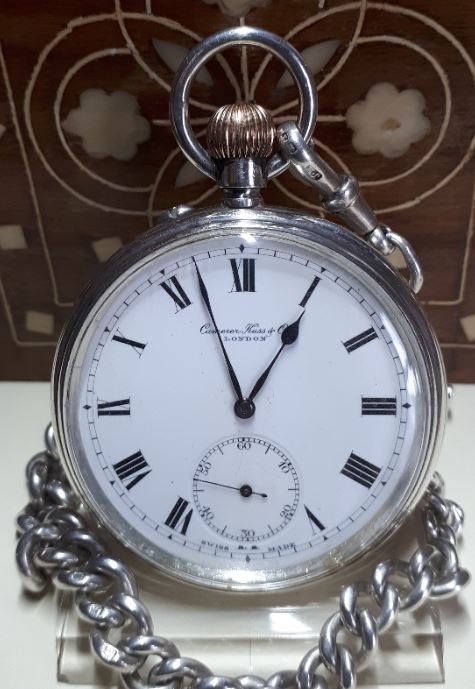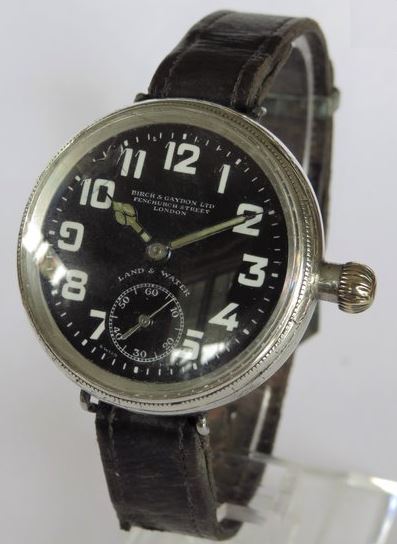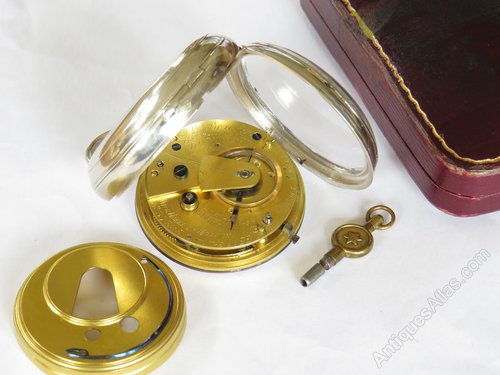Last updated on July 3, 2024
A pocket watch is made to be worn or carried in the pocket and is usually secured by a chain. Pocket watches date back to the 16th century when they were very bulky, terribly inaccurate and some were worn on a chain around the neck.
Pocket watches were the most common type of watch until the early 20th century, which saw the rise in popularity of the wristwatch. During the First World War, wristwatches were developed so that a soldier could simply glance at his wrist instead of taking the time to remove a pocket watch from his tunic. Knowing the time during battle was essential for synchronising attacks. Initially, many pocket watches were modified to fit on the wrist. However, specialised wristwatches were soon be manufactured. These watches began to be known as trench watches.
Pocket watches have made a resurgence over the past decade not least due to the popularity of television period dramas such as Peaky Blinders. They also have a classic beauty, which adds an air of elegance to special occasions. Antique pocket watches are appearing more often in men’s and women’s fashion. Finally, as symbols of fine craftsmanship and engineering, they are great works of practical art that continue to retain and grow in value. As a result, they are seen as a practical and useable investment.
Before you decide which antique pocket watch you want to buy, take a second to think about why you want the watch. Are you buying just one for a special occasion? Or are you about to start a collection of antique pocket watches? If you are collecting do you have a niche in mind? Alternatively, if you are buying antique watches as an investment then there are a few more factors to consider.
Types of Pocket Watches
Open-Face: The open-face pocket watch is perhaps the most well-known of all the pocket watch styles. The affluent Victorian man would typically have an open-faced pocket watch as a fundamental part of his overall outfit. The face is open, which means there is no cover obstructing the dial, making telling the time extremely simple. However, the lack of a cover does make it more likely that the crystal can get scratched or broken.
Hunter Case: A full hunter pocket watch features a solid outer case concealing and protecting the watch’s face until opened. In a half hunter, the watch case features a glass panel or hole in the cover, which allows a partial view of the watch hands.
Case material
The watch cases are typically made from metal. In some pocket watch cases, the material will be a base metal, such as nickel or steel. However, typically the watch case will be of a precious metal such as solid silver or gold. In between, there are cases that have been plated or made of rolled gold. Sterling and carat gold will generally have hallmarks on the inside covers confirming the quality of the case material. If nothing else, the watch will have the scrap value of the case material.
Types of movement
There are two basic types of antique pocket watch movements. Each type has its own unique features and characteristics. Knowing some of the basic movements of antique pocket watches can help to evaluate the watch for its age and value. The type of movement you choose is personal to your taste.
Key-wind, Key-set Movement
Some early pocket watches had key-wind and key-set movements. A key was needed to wind the watch so that the time could be set. This was accomplished by opening the back of the case and inserting the key inside a winding arbor to wind the watch. Likewise, the time was set by inserting the key in a setting arbor and turning. The setting arbor is joined to the minute-wheel, and it moves the hands of the watch. Alternatively, some watches during this era featured the setting arbor at the front of the watch. The crystal and bezel had to be opened to set the time on these watches. The key is fitted over the setting arbor in the centre of the watch and turned. Key operated watches take a little bit more time to set and there is always the chance of losing the key.
Stem-wind, Stem-set Movement
Invented by Adrien Philippe in 1842 and commercialized by Patek Philippe & Co. in the 1850s. This type of movement did away with the need for a watch key. The first of the stem-wind, stem-set watches were sold at London’s Great Exhibition in 1851. The watch also dispensed with the need for the double Albert waistcoat chain. This is a chain with a T-bar in the middle and a length of chain on either side. On this type of chain, the T-bar was secured to a vest, and the watch was clipped to one side and the key to the other. For the new stem-wind, stem-set watches, the single Albert chain was created, which is a single length of chain with a T-bar that is secured to the vest.
Movement quality
Jewels are hard minerals added to the movement of the watch to prevent wear at pivot and collision points. In general, a jewelled watch allows for a more efficient transfer of power from the mainspring to the escapement, which means that a longer and thinner mainspring can be used in the watch. This in turn allows for a longer power reserve. Typically, basic watches start with 7 jewels, which you would consider to be lower grade. Antique watches are considered to be fully jewelled if they have 15 jewels or higher. The jewel count is sometimes, but not always, marked on the movement. It is recommended that collectors focus on fully jewelled watches as these are more likely to hold their value. Be aware that 11-jewel movements can give the appearance of a 15-jewel movement, because the maker has jewelled the top plate, but not the bottom plate.
Brands
Omega, Rolex, Longines, Zenith and Patek Philippe are some of the most well-known Swiss pocket watch manufacturers. These are well-known names and tend to be priced at a premium and are therefore good choices as investment pieces. However, there are many other watchmakers that offer good quality pocket watches at more affordable prices. It’s always good practice to buy the best quality you can afford, as those are the ones that typically retain and grow the most in value. Never underestimate the value of a dial signed, “Swiss made“.
Inspecting the watch
It is always best to buy from reputable dealers. Look for established businesses and dealers with professional qualifications and associations. A well-established or well-known dealer should take the time to answer your questions and will usually be very transparent about any defects or other key factors that a buyer would want to know.
Never buy an antique pocket watch sight unseen. Ideally, you would get to inspect the watch in person, but it’s perfectly fine to do a visual inspection via photographs online. The images should show all aspects of the watch. It should include high-resolution photographs of the case, the dial and the movement.
Case
Damage to the case is also something that will affect the value of a pocket watch. Fine scratches and marks are to be expected on an antique piece and in my opinion add character to the watch. Polishing is always an option, but keep in mind that you are removing a century or more of patina. Even mild bruising to the outer case is acceptable in my view. It is only serious dents to the case material that I try to avoid. If the case is significantly dented then some of that blunt force trauma may have been transferred through to the movement. Always, ensure that the case opens easily. If it needs to be forced it could indicate a damaged alignment or hinges.
Dial
When looking at the dial, examine for hairline cracks or chips around the edges, these are common, but also affect value. If these cracks are clearly visible to the naked eye it is probably not worth purchasing the watch. Also, if the dial looks too new and has no patina it could have been replaced which reduces re-sale value. In addition, check the crystal for obvious scratches or cracks. Also, note what the lens material is. If it is acrylic, it will certainly be a replacement for the original mineral glass.
Movement
The movement should be clean. It is best to avoid watches with any signs of corrosion on the movement. Dirt can be cleaned, but rust is a more serious issue and could have spread throughout the movement. In addition, look at the screws securing the plates and the movement. If they don’t match or some look new then it could indicate that the watch has been repaired with non-original parts which reduces originality and ultimately value.
Accuracy
Is the watch running? If the answer is no, you are likely to be looking at an expensive repair and service bill. Unless you are capable of servicing the watch yourself, it is generally best to avoid non-runners. If the watch is running, determine how accurately it is running and what is the power reserve on a full wind. For an antique pocket watch, I find 2 -3 minutes a day of accuracy is acceptable. That said, I have watches in my collection that run within 1 minute a day of accuracy. The power reserve is a personal preference, I expect a minimum of 16 hours on a full wind, but have the majority of my collection running at 24 hours plus.
If a dealer says the watch has been serviced, be sure to ask what type of service has been carried out. A service could be a full service or just a slight adjustment of the regulator and a dash of oil. A full service includes a complete disassembly/assembly, cleaning and calibrating. A complete full service can cost upwards of £200 by a qualified watchmaker.
Questions to ask
- Has the watch been serviced? If so, what type?
- What is the power reserve when fully wound? Ideally, 24 hours, but this will depend on individual requirements.
- What is the accuracy of the watch over a 24-hour period? Plus, or minus 2 or 3 minutes a day is acceptable for an antique pocket watch.
- How many jewels are in the movement? Aim for 15-jewels or more.
Related content
A beginner’s guide to antique pocket watches.
5 things you should know before purchasing an antique watch.
A list of additional posts regarding antique watches can be found on the Guides page.




